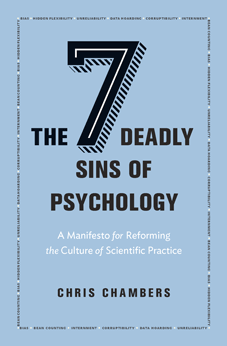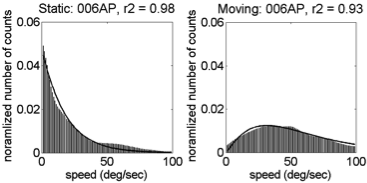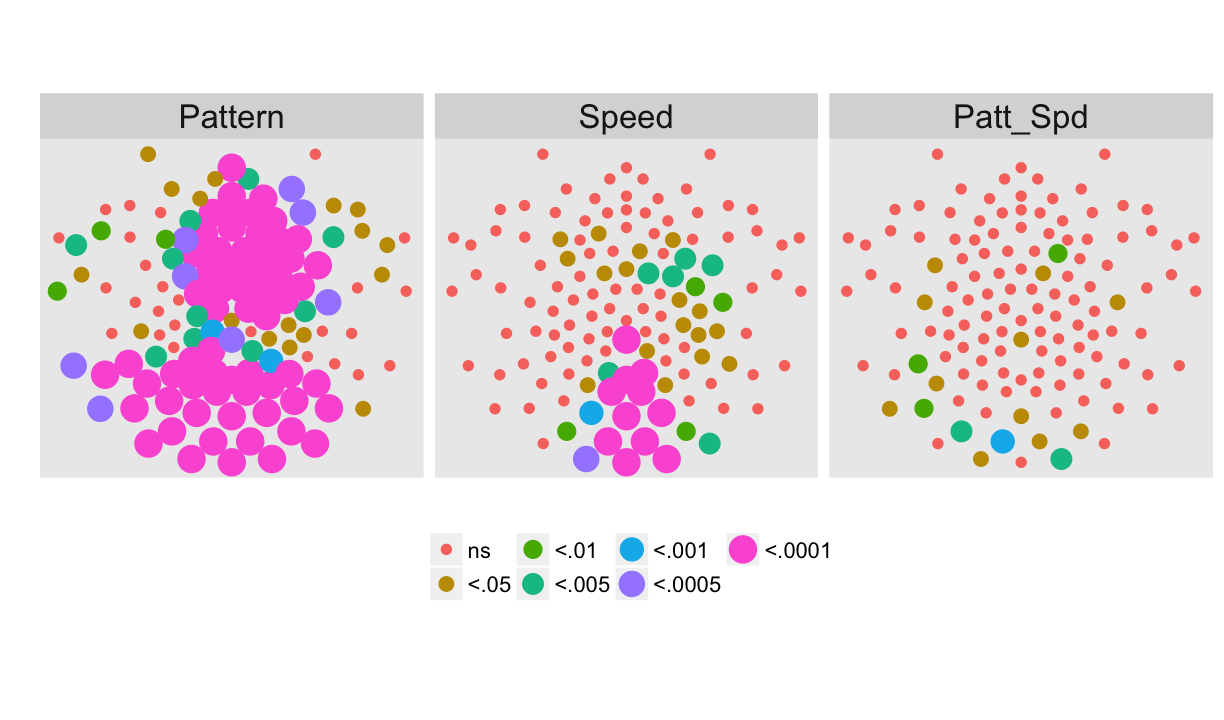The bright future of quantitative developmental science
Rick O. Gilmore
2018-02-14 09:22:05
Preliminaries




Overview
- A temperature-check about open science
- Is the ‘crisis’ in behavioral science also sinful?
- Behavioral science is “big data” science
- Quantitative developmental science has a bright future
- Let’s not waste a “good” crisis





A temperature check about reproducibility and open science
Developmental science could be more open & transparent
Agree | Disagree
Developmental science should be more open and transparent
Agree | Disagree
Openness and transparency are related to research robustness (e.g., reproducibility, reliability, impact)
Agree | Disagree
Data from developmental research should be more widely and readily available
Agree | Disagree
Methods and materials used in developmental research should be more widely and readily available
Agree | Disagree
I have used data shared by others
Agree | Disagree
If data from publication X or project Y were more widely and readily available, I would use it
Agree | Disagree
Unless there are privacy or contractual limitations, data files described in published papers should be readily available in forms reusable by others
Agree | Disagree
I use video or audio recordings in my teaching
Agree | Disagree
I use video or audio recordings in my current research
Agree | Disagree
I can imagine using video or audio recordings in my research
Agree | Disagree
I use video or audio recordings to document my research procedures
Agree | Disagree
I could envision using video or audio recordings to document my research procedures
Agree | Disagree
It’s hard to find and access data that I might want to repurpose
Agree | Disagree
Once found and accessed, there can be a huge cost in “harmonizing” data from different sources
Agree | Disagree
Developments in machine learning, computer vision and related fields are interesting to me
Agree | Disagree
I would be interested in using machine learning, computer vision, or related tools in my research under the right circumstances
Agree | Disagree
I employ reproducible practices and tools (e.g., SPSS or SAS syntax, R code, Jupyter notebooks) in my research workflows
Agree | Disagree
Is there a reproducibility crisis?
- Yes, a significant crisis
- Yes, a slight crisis
- No crisis
- Don’t know
What does “reproducibility” mean?
Methods reproducibility
- Enough details about materials & methods recorded (& reported)
- Same results with same materials & methods

Results reproducibility
- Same results from independent study
Inferential reproducibility
- Same inferences from one or more studies or reanalyses
Reproducibility crisis
- Not just behavioral sciences
- “Hard” sciences, too
- Data collection to statistical analysis to reporting to publishing

Is the crisis in behavioral science also sinful?

The sin of unreliability
Studies are underpowered
“Assuming a realistic range of prior probabilities for null hypotheses, false report probability is likely to exceed 50% for the whole literature.”
The sin of hoarding…

…grants, …students, …data
The sin of corruptibility…
The sin of bias…
Bem, D.J. (2011). Experimental evidence for anomalous retroactive influences on cognition and affect. Journal of Personality and Social Psychology, 100(3), 407-425.
“This article reports 9 experiments, involving more than 1,000 participants, that test for retroactive influence by”time-reversing" well-established psychological effects so that the individual’s responses are obtained before the putatively causal stimulus events occur."
“We argue that in order to convince a skeptical audience of a controversial claim, one needs to conduct strictly confirmatory studies and analyze the results with statistical tests that are conservative rather than liberal. We conclude that Bem’s p values do not indicate evidence in favor of precognition; instead, they indicate that experimental psychologists need to change the way they conduct their experiments and analyze their data.”
The sin of hurrying…

The sin of narrowmindedness…
“…psychologists tend to treat other peoples’ theories like toothbrushes; no self-respecting individual wants to use anyone else’s.”
The sin of pragmatism…
“Reviewers and editors want novel, interesting results. Why would I waste my time doing careful direct replications?”
Any number of researchers I’ve talked with

In our defense…
Behavior multidimensional
Embedded in networks


Humans are diverse
But much (lab-based) data collected are from Western, Educated Industrialized, Rich, Democratic (WEIRD) populations Henrich et al., 2010
Data about humans are sensitive, hard(er) to share
- Protect participant’s identities
- Protect from harm/embarrassment
- Anonymize (effective?) or get permission
Psychology is harder than physics


Beyond sin
- No physics envy, but we can learn from physics
- Openness and transparency are means, not the ends
- How do we accelerate, broaden, and deepen discovery?
- Fixing the past vs. building the future
Behavioral science is “big data” science
“Mind-reading” in fMRI
A personal example
- How does vision develop?
- Experience
- Input +
- Visually-guided action
- Physical (eye/brain/body) development
Measure (in the lab)
- Behavioral sensitivity
- Brain responses
- At different ages
Children’s behavior
Adults’ behavior
Children’s brain responses
Adults’ brain responses
But, what’s the input? The real input?
Frame-by-frame video analysis
Findings
Findings
- Infant (passengers) experience faster visual speeds than mother
- Controlling for speed of locomotion, environment
- Motion “priors” for infants ≠ mothers
Are “fast” flow speeds common?
| Country | Females | Males | Age (wks) | Coded video Hrs |
|---|---|---|---|---|
| India | 17 | 13 | 3-63 | 3.1 (0.5-6.0) |
| U.S. | 15 | 19 | 4-62 | 4.6 (0.2-7.6) |
Motion speeds - 6 weeks
U.S. | India 
 (Gilmore et al, 2015)
(Gilmore et al, 2015)
Motion speeds – 34 weeks
U.S. | India
 (Gilmore et al, 2015)
(Gilmore et al, 2015)
Motion speeds – 58 weeks
U.S. | India
 (Gilmore et al, 2015)
(Gilmore et al, 2015)
Linear > radial patterns
Simulating developmental change
\(\begin{pmatrix}\dot{x} \\ \dot{y}\end{pmatrix}=\frac{1}{z} \begin{pmatrix}-f & 0 & x\\ 0 & -f & y \end{pmatrix} \begin{pmatrix}{v_x{}}\\ {v_y{}} \\{v_z{}}\end{pmatrix}+ \frac{1}{f} \begin{pmatrix} xy & -(f^2+x^2) & fy\\ f^2+y^2 & -xy & -fy \end{pmatrix} \begin{pmatrix} \omega_{x}\\ \omega_{y}\\ \omega_{z} \end{pmatrix}\)
Geometry of environment/observer: \((x, y, z)\) Translational speed: \((v_x, v_y, v_z)\) Rotational speed: \((\omega_{x}, \omega_{y}, \omega{z})\) Retinal flow: \((\dot{x}, \dot{y})\)
Parameters For Simulation
| Parameter | Crawling Infant | Walking Infant |
|---|---|---|
| Eye height | 0.30 m | 0.60 m |
| Locomotor speed | 0.33 m/s | 0.61 m/s |
| Head tilt | 20 deg | 9 deg |
| Geometric Feature | Distance |
|---|---|
| Side wall | +/- 2 m |
| Side wall height | 2.5 m |
| Distance of ground plane | 32 m |
| Field of view width | 60 deg |
| Field of view height | 45 deg |
Simulating Flow Fields
Simulated Flow Speeds (m/s)
| Type of Locomotion | Ground Plane | Room | Side Wall | Two Walls |
|---|---|---|---|---|
| Crawling | 14.41 | 14.42 | 14.43 | 14.62 |
| Walking | 9.38 | 8.56 | 7.39 | 9.18 |
Lessons learned
- Data sharing is AWESOME
- Bigger, densier, richer data sets are AWESOME
- Simulations are AWESOME
- I want to do more AWESOME science than I can do on my own
Quantitative developmental science has a bright future


Essentials for computationally intensive behavioral research
- Computational resources
- Technical expertise
Reproducible workflows
Kitzes, J., Turek, D., & Deniz, F. (Eds.). (2018). The Practice of Reproducible Research: Case Studies and Lessons from the Data-Intensive Sciences. Oakland, CA: University of California Press. E-book.
Findable, Accessible, Interoperable, and Reusable (FAIR) data and materials
Wilkinson, M. D., Dumontier, M., Aalbersberg, I. J. J., Appleton, G., Axton, M., Baak, A., Blomberg, N., et al. (2016). The FAIR Guiding Principles for scientific data management and stewardship. Scientific Data, 3, 160018. Retrieved from http://dx.doi.org/10.1038/sdata.2016.18
Funded NSF (2012-16), NICHD (2013-18), SRCD (2014-16), & Sloan Fdn (2017-18)
Opened spring 2014
Approaching 1,000 researchers (690+ PIs + 300+ affiliates), 380+ institutions
540+ data/stimulus sets (~20% shared), 13,900+ hours

Free, open-source, multi-platform video/audio coding tool
Windows OS fix nearly complete
Updates for transcription
How Databrary differs
- Open sharing among authorized researchers, not public
- Share with community of researchers, not study-by-study
- Share identifiable data with permission via consistent access levels
How Databrary differs
- Store, search across, filter among participant & session characteristics
- Active (during study) curation reduces post hoc burden
- Gilmore, R. O., Kennedy, J. L., & Adolph, K. E. (2018). Practical Solutions for Sharing Data and Materials From Psychological Research. Advances in Methods and Practices in Psychological Science, https://doi.org/10.1177/2515245917746500

Play & Learning Across a Year (PLAY) Project
Play is the central context and activity of early development
What do parents and infants actually do when they play?
Adolph, K., Tamis-LeMonda, C. & Gilmore, R.O. (2016). PLAY Project: Webinar discussions on protocol and coding. Databrary. Retrieved January 24, 2018 from https://nyu.databrary.org/volume/232
Adolph, K., Tamis-LeMonda, C. & Gilmore, R.O. (2016). PLAY Project: Materials. Databrary. Retrieved January 24, 2018 from https://nyu.databrary.org/volume/254.

- \(n=900\) infant/mother dyads; 300 @ 12-, 18-, 24-months
- 30 dyads from 30 sites across the US
- 1 hr natural activity
- 3 min solitary toy play
- 2 min dyadic toy play
- video tour of home
- Videos coded for
- Emotional expression
- Object interaction
- Physical activity & locomotion
- Full transcript, Communication, and Gesture
- Enhancements to Datavyu for transcription, CHAT compatibility, Windows support
Demographics + parent-report questionnaires about health, family, temperament, vocabulary
Ambient sound levels

Census block group geocoding


- Data openly shared on Databrary
- Adolph, K., Tamis-LeMonda, C. & Gilmore, R.O. (2016). PLAY Project: Materials. Databrary. Retrieved January 24, 2018 from https://nyu.databrary.org/volume/254.
- Adolph, K., Tamis-LeMonda, C. & Gilmore, R.O. (2017). PLAY Pilot Data Collections. Databrary. Retrieved January 24, 2018 from https://nyu.databrary.org/volume/444
Video as data AND documentation
What questions would you ask about these sorts of data?
How could the data be made maximimally (re)useful?
On the horizon..
- Scientific process management (LabNanny), project sync, dataset cloning
- Bringing machine learning, computer vision to behavioral scientists
Let’s not waste a “good” crisis


Collect & share video as data and documentation

Increase sample sizes

Standardize metadata
- participants (age, gender, race/ethnicity, …)
- settings (times, dates, places)
- measures & tasks

Improve statistical practices
- Automated checking of paper statistics (in American Psychological Association formats) via Statcheck
- Redefine “statistical significance” as \(p<.005\)? (Benjamin et al., 2017)
- Or move away from NHST toward more robust and cumulative practices (Bayesian, CI/effect-size-driven)
Store data, materials, code in repositories
- Data libraries
- Funder, journal mandates for sharing increasing
- But no long-term, stable, funding sources for curation, archiving, sharing
- ArXiv model
- Institutional (Cornell) support
- Subscription
Build platforms for discovery
- Data + analysis
- e.g., PSU’s Biostars


Data from diverse domains



Link measures across people
Web-based data visualization, analysis
Search, filtering by personal characteristics
Curate data & materials as they are generated

Consistent, clear sharing permissions structure

And/or let individuals own/profit from their own data

Boker, S. M., Brick, T. R., Pritikin, J. N., Wang, Y., von Oertzen, T., Brown, D., Lach, J., et al. (2015). Maintained Individual Data Distributed Likelihood Estimation (MIDDLE). Multivariate behavioral research, 50(6), 706–720. Taylor & Francis. Retrieved from http://dx.doi.org/10.1080/00273171.2015.1094387
Compete over findings, not participants…


Progress
| Example | Multi-measure | Indiv link/search | Visualize | Self-curate | Permissions |
|---|---|---|---|---|---|
| Databrary | ✔ | ✔ | tabular | ✔ | ✔ |
| Human Proj | ✔ | ✔ | ? | ? | ✔ |
| ICPSR | ✔ | ? | ✔ | ? | ✔ |
| Neurosynth | fMRI BOLD | group data | ✔ | public | NA |
| OpenNeuro | ✔ | ? | ✔ | ✔ | public |
| Open Humans | ✔ | ✔ | ? | ? | ✔ |
| OSF | ✔ | ✔ | public | ||
| WordBank | M-CDI | group metadata | ✔ | ? | public |





Keep in touch
rogilmore@psu.edu
gilmore-lab.github.io
Stack
This talk was produced on 2018-02-14 in RStudio using R Markdown and the reveal.JS framework. The code and materials used to generate the slides may be found at https://github.com/gilmore-lab/2018-02-14-quant-dev/. Information about the R Session that produced the code is as follows:
## R version 3.4.1 (2017-06-30)
## Platform: x86_64-apple-darwin15.6.0 (64-bit)
## Running under: macOS Sierra 10.12.6
##
## Matrix products: default
## BLAS: /System/Library/Frameworks/Accelerate.framework/Versions/A/Frameworks/vecLib.framework/Versions/A/libBLAS.dylib
## LAPACK: /Library/Frameworks/R.framework/Versions/3.4/Resources/lib/libRlapack.dylib
##
## locale:
## [1] en_US.UTF-8/en_US.UTF-8/en_US.UTF-8/C/en_US.UTF-8/en_US.UTF-8
##
## attached base packages:
## [1] stats graphics grDevices utils datasets methods base
##
## other attached packages:
## [1] DiagrammeR_0.9.2 revealjs_0.9
##
## loaded via a namespace (and not attached):
## [1] Rcpp_0.12.12 compiler_3.4.1 RColorBrewer_1.1-2
## [4] influenceR_0.1.0 plyr_1.8.4 bindr_0.1
## [7] viridis_0.4.0 tools_3.4.1 digest_0.6.12
## [10] jsonlite_1.5 viridisLite_0.2.0 gtable_0.2.0
## [13] evaluate_0.10.1 tibble_1.3.3 rgexf_0.15.3
## [16] pkgconfig_2.0.1 rlang_0.1.2 igraph_1.1.2
## [19] rstudioapi_0.6 yaml_2.1.14 bindrcpp_0.2
## [22] gridExtra_2.2.1 downloader_0.4 dplyr_0.7.2
## [25] stringr_1.2.0 knitr_1.17 htmlwidgets_0.9
## [28] hms_0.3 grid_3.4.1 rprojroot_1.2
## [31] glue_1.1.1 R6_2.2.2 Rook_1.1-1
## [34] XML_3.98-1.9 rmarkdown_1.6 ggplot2_2.2.1
## [37] tidyr_0.6.3 purrr_0.2.3 readr_1.1.1
## [40] magrittr_1.5 backports_1.1.0 scales_0.5.0
## [43] htmltools_0.3.6 assertthat_0.2.0 colorspace_1.3-2
## [46] brew_1.0-6 stringi_1.1.5 visNetwork_2.0.1
## [49] lazyeval_0.2.0 munsell_0.4.3
 (
( (
( (
(




 (
(

 (
( (
( (
(

 (
( (
( (
( (
( (
(








